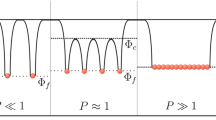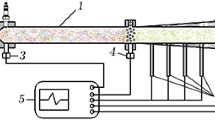Abstract
A light-erosion method for generating high-pressure dust-gas-plasma flows during ultraviolet (λ = 213 nm) laser ablation of a polymeric matrix ((C2F4) n ) containing dust particles (thin-wall borosilicate glass microspheres with a ∼15- to 80-μm diameter d) is described. The carrying-out of the dust particles by ionized vapors of the substance of the target matrix, their space-time localization in the gas-plasma flow in a period Δτ ∼ 15–75 μs after the laser exposure up to the further spatial separation of the vaporized substance of the target matrix and the dust particle cloud is recorded by laser interferometry and shadow photography methods. The importance of certain selection of the matrix-dust system for realizing the light-erosion method for generating dust-gas-plasma flows, in particular laser exposure conditions, is shown. When condensed media with a low ionization potential (Al, Ce) are used as a dust component, the proposed method for generating heterogeneous gas-plasma flows can be efficient for their further heating by coherent radiation.
Similar content being viewed by others
References
Entsiklopediya nizkotemperaturnoi plazmy “Pylevaya plazma” (Encyclopedia of Low-Temperature Plasma. Dusty Plasma), Moscow: Yanus-K, 2006, vols. 1–2.
Bliokh, P., Sinitsin, V., and Yaroshenko, V., Dusty and Self-Gravitational Plasmas in Space, Dordrecht: Academic, 1995.
Vaulina, O.S., Petrov, O.F., Fortov, V.E., et al., Pylevaya plazma: teoriya i eksperiment (Dusty Plasma: Theory and Experiment), Moscow: Fizmatlit, 2009.
Whipple, E.C., Rep. Prog. Phys., 1981, vol. 44, p. 1197.
Robinson, P.A. and Coakley, P., IEEE Transactions Electr. Insulation, 1992, vol. 27, p. 944.
Winter, J., Phys. Plasmas, 2000, vol. 7, p. 3862.
Bulychev, S.V., Vyalykh, D.V., Dubinov, A.E., et al., Prib. Tekh. Eksp., 2006, no. 4, p. 126 [Instrum. Exp. Tekh. (Engl. Transl.), 2006, no. 4, p. 568].
Fortov, V.E., Vaulina, O.S., Petrov, O.F., et al., Pis’ma Zh. Eksp. Teor. Fiz., 2005, vol. 82, p. 549 [J. Exp. Theor. Phys. Lett., 2005, vol. 82, no. 8, p. 492].
Kosov, V.F., Molotkov, V.I., and Nefedov, A.P., Teplofiz. Vys. Temp., 1991, vol. 29, p. 633.
Golubev, E.M., Levina, O.V., Pukhov, A.M., et al., Opt. Spektrosk., 1999, vol. 86, p. 382.
Costela, A., Garcia-Moreno, I., Florido, F., et al., J. Appl. Phys., 1995, vol. 77, p. 2343.
Tsuboi, Y., Kuro-Oka, T., Irie, K., et al., Appl. Phys. A: Material. Sci. Process, 2004, vol. 78, p. 339.
Fortov, V.E., Nefedov, A.P., Petrov, O.F., et al., Zh. Eksp. Teor. Fiz., 1997, vol. 111, p. 467 [J. Exp. Theor. Phys., 1997, vol. 111, no. 3, p. 489].
Ticos, C.M., Wang, Z., Wurden, G.A., et al., Phys. Rev. Lett., 2008, vol. 100, p. 155002.
Author information
Authors and Affiliations
Corresponding author
Additional information
Original Russian Text © E.Yu. Loktionov, Yu.Yu. Protasov, 2010, published in Pribory i Tekhnika Eksperimenta, 2010, No. 4, pp. 145–149.
Rights and permissions
About this article
Cite this article
Loktionov, E.Y., Protasov, Y.Y. A light-erosion method for high-pressure dust-gas-plasma flows generation. Instrum Exp Tech 53, 601–606 (2010). https://doi.org/10.1134/S0020441210040238
Received:
Published:
Issue Date:
DOI: https://doi.org/10.1134/S0020441210040238




